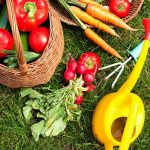Best Plants For Home Vegetable Garden
There is a lot of debate over what is the best vegetable to plant in a home garden. The answer to this question really depends on your climate, the size of your garden, and your personal preferences. However, there are some vegetables that are better suited for home gardens than others.
If you live in a climate that is warm year-round, then you can grow a variety of vegetables in your garden. However, if you live in a climate that has seasons, then you will want to plant vegetables that grow well in your region’s climate.
Below is a list of some of the best plants for a home vegetable garden.
Tomatoes
Tomatoes are a great choice for a home garden because they grow well in a variety of climates and they are relatively easy to grow. Tomatoes are also a versatile vegetable, and they can be used in a variety of recipes.
Peppers
Peppers are another great choice for a home garden. They grow well in a variety of climates and they are easy to grow. Peppers can be used in a variety of recipes, and they are a good source of vitamin C.
Zucchini
Zucchini is a good choice for a home garden because it grows well in a variety of climates and it is easy to grow. Zucchini is also a versatile vegetable, and it can be used in a variety of recipes.
Spinach
Spinach is a good choice for a home garden because it grows well in a variety of climates and it is easy to grow. Spinach is also a good source of nutrients, including vitamin A, vitamin C, and iron.
There are a number of other vegetables that can be grown in a home garden, including carrots, onions, and potatoes. These vegetables are all easy to grow and they are a good source of nutrients.
How To Get The Best Vegetable Garden
There are a lot of factors to consider when planning and planting your vegetable garden. The first step is to assess your needs and space. Make a list of the vegetables you and your family enjoy, and then find out how much space each one will need. Once you have an idea of the layout of your garden, you can start to select the best plants and soil for your needs.
Most vegetables need at least six hours of sunlight per day, so make sure to place your garden in an area that gets plenty of sun. If you don’t have a lot of space, consider growing vegetables in containers. There are a variety of containers to choose from, including pots, barrels, and raised beds. You can also mix vegetables together in one container to save space.
When choosing plants, make sure to select ones that are suited to your climate. Some vegetables, like tomatoes, need a lot of warmth and sunlight, while others, like spinach, can grow in cooler climates. It is also important to choose plants that are resistant to pests and diseases. You can ask your local garden center for advice on which plants are best suited to your area.
The soil in your garden should be rich in nutrients to help your plants grow healthy and strong. You can improve the soil by adding compost or manure. Vegetables also need plenty of water, so make sure to water your garden regularly, especially during the summer months.
By following these tips, you can create a beautiful and bountiful vegetable garden that will provide you with fresh, delicious produce all season long.
Best Weed And Grass Killer For Vegetable Garden
:
There are many weed and grass killers on the market, but not all of them are safe for vegetable gardens. The best weed and grass killer for vegetable gardens is a product called BurnOut. BurnOut is a non-selective herbicide that kills all plants it comes in contact with. It is made from a formula of vinegar and citrus oil, which makes it safe for use around vegetables and other plants. BurnOut is also biodegradable, so it won’t harm the environment.
If you are looking for a weed and grass killer that is safe for use in vegetable gardens, BurnOut is the product for you.
Best Way To Get Soil Ready For A Vegetable Garden
It can be tough to get your soil ready for a vegetable garden, but with a little bit of effort, you can create a garden that will provide you with fresh vegetables all season long. The first step is to test your soil to see what kind of condition it is in. You can do this by taking a soil sample to your local garden center and having it tested. They will be able to tell you what kind of amendments you need to add to your soil to make it more fertile.
Once you know what needs to be done to improve your soil, it’s time to get to work. One of the best ways to get your soil ready for a vegetable garden is to add organic matter to it. This can be done by adding compost, manure, or peat moss to your soil. These organic materials will help to improve the structure of the soil and make it more fertile.
Another way to improve the soil in your garden is to till it. Tillering helps to break up the soil and mix in the organic matter that you added. It also helps to get rid of any weeds or clumps of dirt that may be in the soil. You can either use a tiller or a spade to till the soil.
Once the soil is tilled, it’s time to plant your vegetables. Be sure to follow the instructions that come with your plants, as each type of vegetable has its own specific needs. By taking the time to prepare your soil properly, you will be able to enjoy a bountiful harvest of fresh vegetables all season long.
Best Way To Plant Your Vegetable Garden
In order to have a successful vegetable garden, you need to plan ahead and choose the right plants for your climate and growing conditions. You also need to make sure you have the proper tools and supplies, and that you know how to plant and care for your vegetables.
The best way to plant your vegetable garden is to start by drawing a map of your garden. This will help you plan the layout of your garden and determine how much space each vegetable will need. It’s also a good idea to mark where the sun hits your garden throughout the day, so you can plant your vegetables in the most sun-friendly locations.
Once you have your map drawn, it’s time to start planting. Begin by digging a hole for each vegetable, and adding some organic matter such as compost or manure. Then, place the vegetable in the hole and cover it with soil. Be sure to water your vegetables regularly, and to fertilize them once a month.
If you follow these simple steps, you will be able to enjoy a bountiful harvest from your own vegetable garden.
“

If you’re looking to get into vegetable gardening, or are just looking for some tips on how to make your current garden better, then you’ve come to the right place! My name is Ethel and I have been gardening for years. In this blog, I’m going to share with you some of my best tips on how to create a successful vegetable garden.





